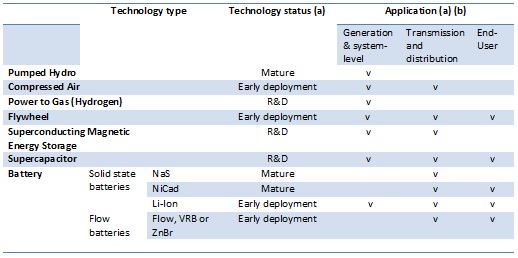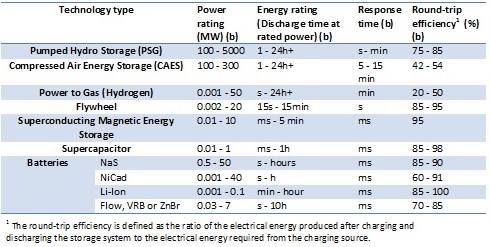
Joint Letter – Urgent Need to Scale Up Industrial Carbon Management in Europe
To reach the ambition of climate neutrality by 2050, the EU needs to make sure that all available decarbonisation technologies can reach their full p...
News

Publish date: May 1, 2014
News
European energy supply is changing, with renewables supplying more of the energy needs of business and consumers. However, much of the renewables being deployed are an intermittent source of electricity, only providing to the grid when resources such as wind, solar or wave are available.
This has the resulting benefit of lower electricity prices when renewables can generate, but a rise in prices when traditional power plants are called upon to meet demand. In addition, the requirement to have such traditional plant to backup renewables has resulted in a rising total electrical supply system cost. Such an outcome prevents the true price advantage of renewables being transferred to consumers. Large scale electricity storage can effectively reduce intermittency of renewables like wind and photovoltaic (PV) output, and allow sale of renewable electricity when it is most needed. Intermittent renewables can also increase strain on certain grid infrastructure such as transition lines, causing energy fluctuation and congestion.
In practice, when intermittent renewable share is lower than 15% to 20 % of overall electricity consumption, the need for underutilised backup generation plant is not great while fluctuations caused are still manageable for the grid operators to compensate for.
However, as the share exceeds 20-25% (as e.g. at times in Denmark, Spain or Germany) renewables begin to have a more dominating position effecting both the technical operation and the market operation of the electricity supply system. It is in this case that different electricity storage technologies become crucial to avoid grid perturbation (frequency, voltage) while helping to prevent grid congestion. Large scale electricity storage would also help prevent unnecessary, expensive, import dependent and polluting fossil backup generation capacity.
It is clear that electricity storage technologies and RES complement each other.

In order to understand the opportunities to store electricity, one must first make clear the composition of the electricity market. The electric power industry, or in other words the electricity market, is built on three main pillars.
Electricity generation is the first and foremost pillar, sourcing power in a multitude of ways: i.e. nuclear power stations, combined-cycle gas turbine facilities, coal power plants or from renewable energy sources like wind or solar farms etc. The electrical current from generation points is then injected into the ‘second pillar’: (high-voltage) transmission system or directly into (medium or low-voltage) distribution systems before being delivered to the end customer such as industry or residential customers. The end-users create the final, third pillar.
Due to the fact that the energy industry is so varied, and because of the numerous capital and operating parameters of storage technologies there is no ‘best’ technology that suits all circumstances. Optimising the deployment of different technologies along their numerous applications in the value chain is complex. The storage technologies outlined below can prove more useful in various parts of the electricity system depending on their characteristics.
A variety of storage applications are available, at different stages of development and deployment:
Pumped storage hydropower (PSH) systems utilise elevation changes to store off-peak electricity for later use. Water is pumped from a lower reservoir to a reservoir at a higher elevation during off-peak periods. Subsequently, water is allowed to flow back down to the lower reservoir when needed, generating electricity in a fashion similar to a conventional hydropower plant.
Compressed air energy storage (CAES) systems use off-peak electricity to compress air, storing it in underground caverns or storage tanks. This air is later released to a combustor in a gas turbine to generate electricity during peak periods.
Power to gas (hydrogen) storage uses hydrogen as an energy carrier to store electricity, for example through electrolysis. Electricity is converted, stored, and then re-converted into the desired end-use form (e.g. electricity, heat, or liquid fuel).
Flywheels are mechanical devices that spin at high speeds, storing electricity as rotational energy. This energy is later released by slowing down the flywheel’s rotor, releasing quick bursts of energy (i.e. releases of high power and short duration).
Superconducting magnetic energy storage (SMES) systems store energy in a magnetic field. This field is created by the flow of direct current (DC) electricity into a super-cooled coil. In low-temperature superconducting materials, electric currents encounter almost no resistance, so they can cycle through the coil of superconducting wire for a long time without losing energy.
Supercapacitors store energy in large electrostatic fields between two conductive plates, which are separated by a small distance. Electricity can be quickly stored and released using this technology in order to produce short bursts of power.
Batteries use chemical reactions with two or more electrochemical cells to enable the flow of electrons:

Two aspects of electricity are important to understanding technology and applications of energy storage: power and energy. Energy can be thought of as a volume (i.e. a kilowatt-hour), while power can be thought of as a rate of flow (i.e. a kilowatt). Some applications, such as load shifting across hours, require a large volume of energy storage capacity. A storage device like pumped hydroelectric power is well suited for this type of application. Other applications, such as real-time voltage stabilisation, require a large responsive power capacity. A storage device like a flywheel is well suited for this type of application. It is important to match the application with the best suited storage technology.

For the generation and system level, pumped hydropower storage (PHS) is the most advantageous due to maturity, high power rating (100-5000 MW), long discharge time vs short response time and a round-trip efficiency of 75-85%. However at the same time, PHS faces limitations of new site availability.
Moreover, PHS along with compressed air storage (CAES ) are the only technologies able to be deployed at the scale of hundreds of MW today, making them most suitable for providing transmission arbitrage and reserve power. However, the former has the advantage over CAES due to its greater round trip efficiency and lower self-discharge. Conversely, CAES can be deployed in many places where pumped hydro is not suitable. More and more, batteries are becoming an alternative in providing a significant backup.
Concerns about the availability of future sites for technologies such as hydropower are reduced if storage technologies are located in smaller units on the distribution system – a concept, which is known as distributed energy storage. Less mainstream storage technologies like batteries and flywheels are usually considered for this type of distributed deployment and in small electricity grids, e.g. on islands which need only small scale solutions. However the improving competitiveness and availability of technologies such as Li-Ion batteries will see them playing an increasing role in system scale electricity storage.
The third pillar of the electricity market, the end-users, can find an application for most of the above-mentioned technologies in various circumstances. Except for PHS and CAES, which are high power rating and large-scale technologies, end-users have the flexibility to apply solution-oriented technologies according to their requirements.
One needs to remember that the described situation is changing rapidly as technologies develop and in the nearest future the application of various energy storage technologies can be even more diverse and cost effective than it is now.

To reach the ambition of climate neutrality by 2050, the EU needs to make sure that all available decarbonisation technologies can reach their full p...

The 4th annual Industrial Carbon Management Forum (ICM Forum), formerly known as the CCUS Forum, took place last week (10–11 October) in Pau, France—...

Bellona Europa, alongside 22 organisations, representing impacted industry associations, think tanks andcivil society organisations urge the European...

A forum for inquiry, collaboration and scrutiny: on the occasion of Bellona Europa’s 30th anniversary in Brussels, the first Bellona Climate Action C...
Get our latest news